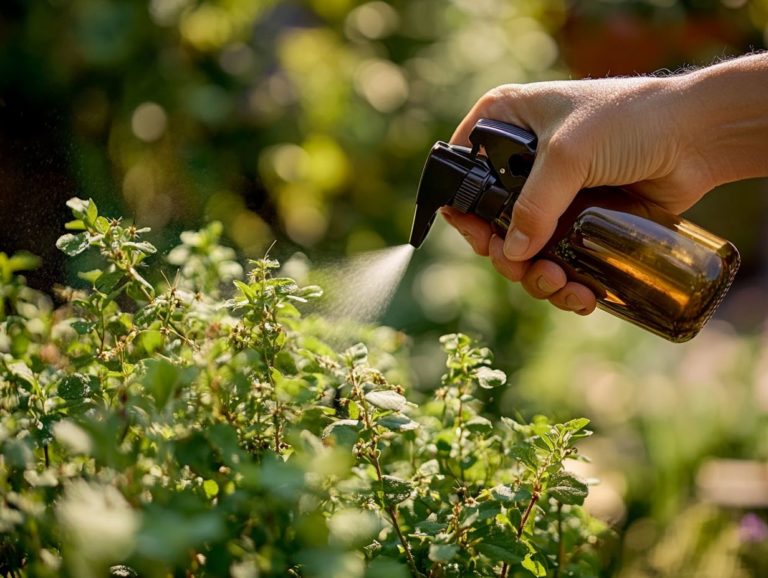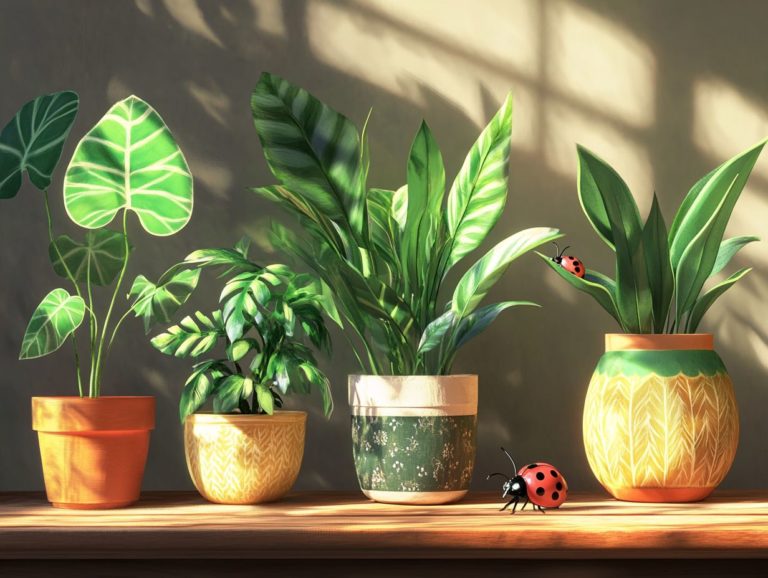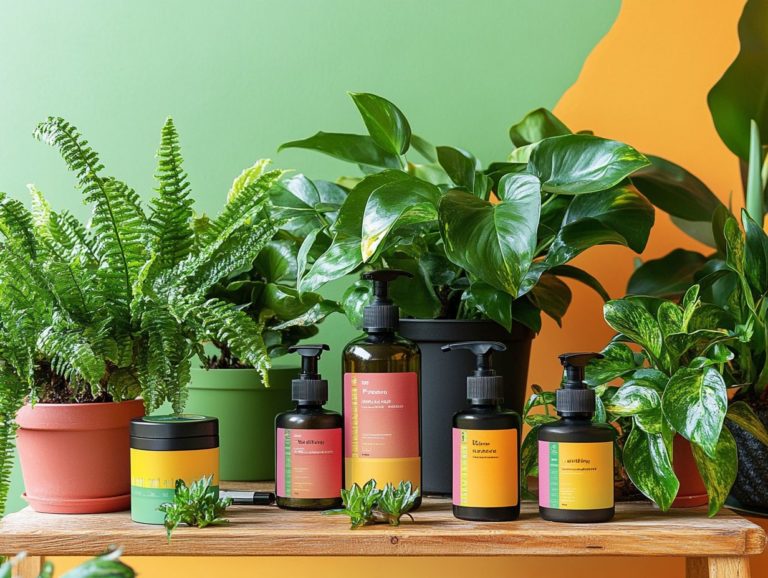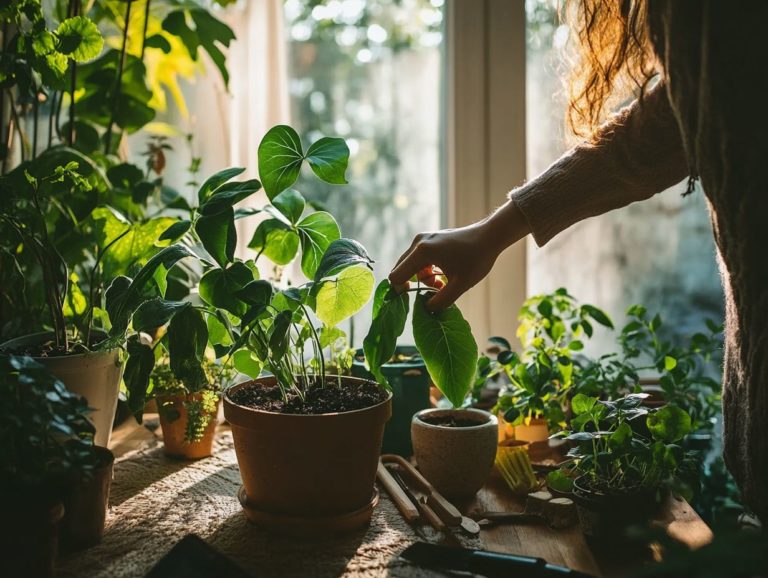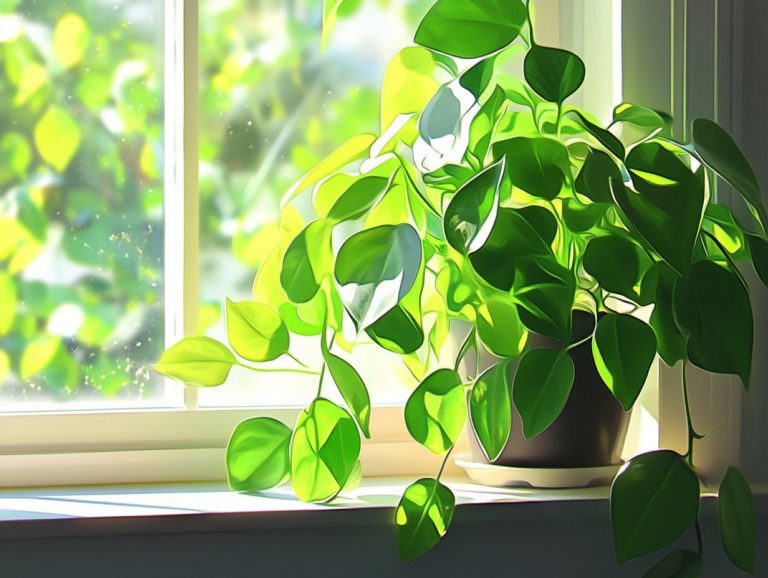Common Mistakes in Indoor Plant Pest Control
Indoor plants can transform your space! But be careful pests can threaten their beauty and health. Caring for these green companions goes beyond mere watering and sunlight; a solid understanding of pest control is essential for their well-being.
This article delves into the common missteps that plant owners often make, such as misidentifying pests and resorting to harsh chemicals. It also presents effective methods, including natural pest control solutions and indispensable care tips.
Immerse yourself in this knowledge to ensure your indoor plants not only survive but truly flourish!
Contents
- Key Takeaways:
- Common Mistakes in Indoor Plant Pest Control
- Effective Methods for Indoor Plant Pest Control
- Frequently Asked Questions
- What are some common mistakes to avoid in indoor plant pest control?
- How can overwatering be a mistake in indoor plant pest control?
- Why is using improper or expired pesticides a mistake in indoor plant pest control?
- Why is properly identifying the pest important in indoor plant pest control?
- How often should I check my plants for signs of pests?
- What are some natural remedies for indoor plant pest control?
Key Takeaways:
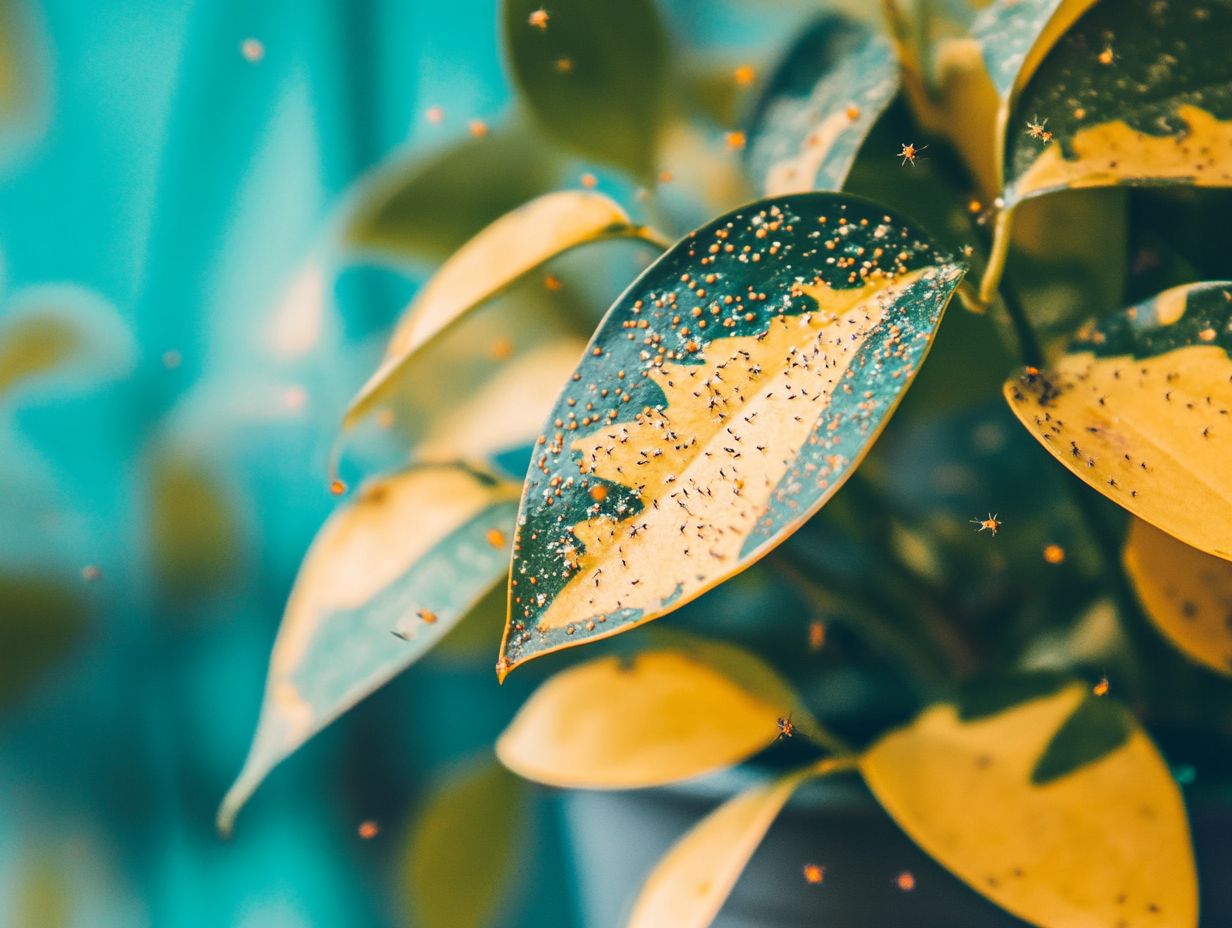
- Avoid chemical pesticides as they can harm your plants and indoor environment.
- Identify pests accurately for effective solutions.
- Proper watering and care are essential to prevent pest issues.
Why is Pest Control Important for Indoor Plants?
Pest control is crucial for the health of your indoor plants, including varieties like African violets and fiddle leaf figs. Without it, your plants may suffer from pests like spider mites and mealybugs, which can inflict damage threatening their growth.
When you prioritize pest control, your plants can absorb vital nutrients and flourish in their environment. This includes maintaining best humidity levels and regularly checking for signs of infestation.
Neglecting to keep an eye on these delicate specimens can result in stunted growth, unsightly discoloration, and even plant death. Pests can interfere with the process plants use to make their food, called photosynthesis, undermining your plants resilience against diseases.
By adopting proactive plant care strategies like inspecting the undersides of leaves for tiny eggs or webs you can effectively prevent these unwelcome intruders from taking hold. Adjusting humidity levels not only boosts plant health but also creates an environment that is less inviting to pests, paving the way for lush, vibrant growth.
Common Mistakes in Indoor Plant Pest Control
In the realm of indoor plant care, it’s crucial to recognize several common pitfalls that can compromise your pest control efforts and jeopardize the health of your beloved houseplants.
If you fail to accurately identify pests like fungus gnats, aphids, or spider mites, you risk employing the wrong treatment methods. This not only wastes your time and resources but also allows infestations to escalate.
Neglecting essential preventive measures or mismanaging your watering schedule can foster an environment ripe for pest outbreaks, making your plant care journey even more challenging.
Using Chemical Pesticides
While chemical pesticides might seem like a quick fix for those pesky houseplant invaders, they can jeopardize both your plants health and the indoor air quality. Many plant care experts, including those at Iowa State University, suggest turning to alternatives like insecticidal soap or neem oil. These options effectively manage pests without the harmful side effects often linked to synthetic chemicals.
Horticultural oil is another effective option, tackling soft-bodied insects while being gentler on the environment.
Relying on synthetic solutions can lead to a host of problems, such as stress in your plants and weakened immunity, making them prime targets for future infestations. Plus, inhaling those harmful chemicals can pose a risk to anyone in the enclosed space.
In contrast, insecticidal soap suffocates pests, while neem oil disrupts their life cycles, providing a proactive approach to pest control. Horticultural oil not only targets existing nuisances but also acts as a preventative measure against new infestations.
By choosing these natural alternatives, you create a safer haven for your plants and all who share the space, promoting long-term health and well-being.
Now that you re armed with this knowledge, put it into practice and watch your indoor plants thrive!
Not Identifying the Pest Correctly

Identifying pests accurately is crucial for effective indoor plant care. Each pest requires a different management plan.
If you misidentify pests like spider mites or mealybugs, your treatments may fail. This prolongs infestations and threatens your plants’ health.
Spider mites weave delicate webs on the undersides of leaves and cause yellow speckles. Whiteflies are small, white, and often found underneath leaves.
Mealybugs leave a waxy substance that indicates their presence. Spotting these signs early boosts your pest control efforts.
Choosing effective treatments like insecticidal soaps, natural predators, or growing techniques is essential. This proactive approach keeps your indoor greenery thriving.
Over or Under Watering
Over or under-watering is a frequent pitfall for plant enthusiasts. This stress makes plants more vulnerable to pests and diseases.
You must establish a consistent watering schedule tailored to each plant s needs. Monitor soil moisture and humidity levels closely.
Tropical plants need different care than hardy houseplants. Understanding these differences enhances your pest control efforts.
Neglecting moisture levels can lead to root rot or dryness. Both conditions create a welcoming space for pests like fungus gnats and spider mites.
Excess water may invite mold growth, while dry conditions stress plants. This makes them easy targets for infestations.
Look for signs of distress, such as yellowing leaves or stunted growth. Adjust your watering habits accordingly to help your plants thrive.
Not Taking Preventive Measures
Neglecting preventive measures raises the risk of pest infestations. Adopt proactive pest management strategies to protect your plants.
Regularly clean your houseplants and isolate any infested specimens. Use products like mosquito bits to act as effective deterrents.
These actions enhance plant health and foster a sustainable indoor gardening environment. Proper watering practices also play a crucial role.
Keep an eye on humidity levels and ensure good air circulation. This creates an inhospitable environment for pests.
Regularly inspect leaves and soil for unwanted visitors. Promptly remove dead or decaying plant material for effective pest management.
Effective Methods for Indoor Plant Pest Control
Employing effective methods for indoor plant pest control is crucial for safeguarding the health of your houseplants. Strive to cultivate a flourishing indoor garden.
Opt for natural and organic pest control solutions like mosquito bits and horticultural oils. These manage pests while preserving plant vitality.
Follow comprehensive plant care guidelines, including regular inspections and preventive measures. This will elevate your indoor plant care and pest management efforts.
Don’t wait to act! Check your plants today to ensure a healthy growing environment.
Natural and Organic Pest Control Options
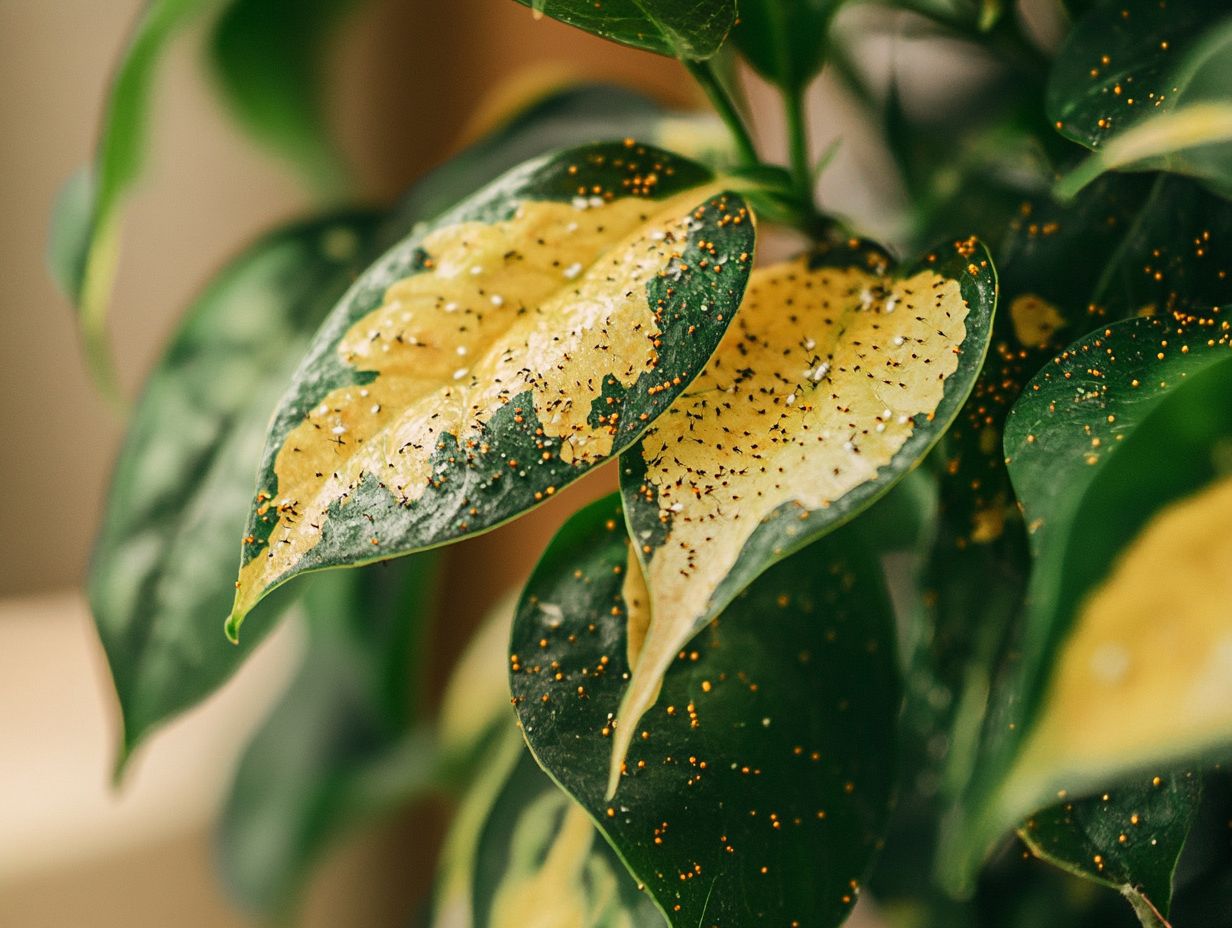
Natural and organic pest control options are becoming the go-to choice for indoor gardeners looking for effective and environmentally friendly ways to tackle pests. Products such as neem oil and insecticidal soap have earned their stripes for managing pesky invaders like aphids and spider mites. They are safe for both your plants and yourself.
Using mosquito bits can be a game-changer, targeting larvae in the soil and thwarting potential pest outbreaks before they start.
These alternatives not only protect beneficial insects but also help create a healthier environment overall. You might consider incorporating essential oils, like peppermint or lavender, to create a fragrant barrier against unwelcome guests. Just mix a few drops with water in a spray bottle and apply it directly to the affected areas.
Diatomaceous earth, a natural powder made from fossilized algae, acts as a barrier to pests. Its fine powder can dehydrate and eliminate soft-bodied insects upon contact.
Using companion planting strategies can help cultivate a more resilient garden environment. Integrating marigolds or basil can self-regulate pest populations, demonstrating the effectiveness and safety of these organic methods.
Proper Watering and Plant Care Techniques
Mastering the art of proper watering and plant care techniques is essential for keeping your houseplants healthy and pest-free. By understanding the specific needs of each plant like optimal soil moisture and humidity levels you can create ideal conditions that promote growth and deter pesky intruders.
For instance, tropical plants have different watering needs compared to hardier varieties. Tailoring your care approach is crucial.
Consistent moisture levels play a vital role in preventing mold and mildew, which can invite pests into your home. Techniques like bottom watering or using self-watering pots can help ensure your plants receive just the right amount of hydration without drowning their roots. For more insights, check out the top 7 mistakes in watering indoor plants. Keeping an eye on humidity levels is equally important since many pests thrive in dry conditions.
Regular misting or setting up a humidity tray for those sensitive plants can keep them thriving and fend off unwanted visitors. By harmonizing your watering and environmental strategies, you can significantly reduce the risk of infestations and cultivate a lush, vibrant indoor garden.
Regular Inspections and Early Intervention
Inspect your plants regularly to catch pests early and keep them healthy. This proactive approach allows you to identify issues before they spiral into major infestations. Check your plants for signs of pests, like the sticky residue left by aphids or the telltale webbing of spider mites. Taking immediate action to combat these nuisances safeguards your plants’ health and nurtures a more resilient indoor garden environment!
Establish a routine that involves examining both the undersides of leaves and the soil for any unusual changes. Keeping a journal can be invaluable in tracking your plants’ health over time, making it easier to spot patterns or recurring problems related to plant needs.
Consider using magnifying glasses to spot any hidden pests. Don’t hesitate to implement natural remedies such as neem oil or insecticidal soap to mitigate damage. Ensuring adequate airflow and practicing proper watering techniques can significantly reduce the likelihood of pest infestations.
Ultimately, these small but consistent efforts greatly contribute to the overall well-being of your houseplants, ensuring they thrive beautifully.
Frequently Asked Questions
What are some common mistakes to avoid in indoor plant pest control?
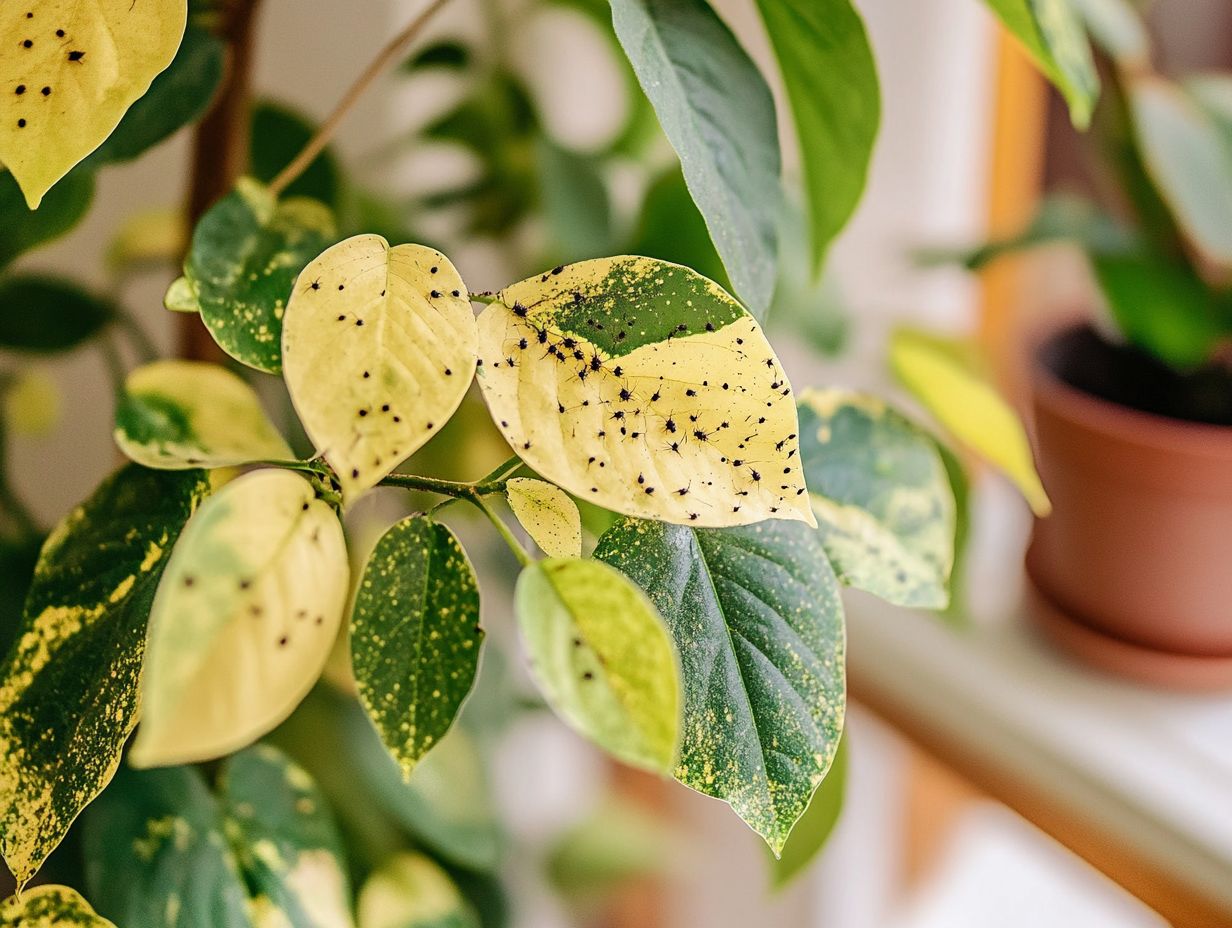
Some common mistakes to avoid in indoor plant pest control include overwatering, using expired pesticides, failing to identify the pest, and not regularly checking plants for signs of pests. It s crucial to understand the watering schedule that suits your plants best.
Are you making these common mistakes?
How can overwatering be a mistake in indoor plant pest control?
Overwatering creates a cozy home for pests. It can lead to root rot and weaken your plant’s ability to fend off invaders.
Water your plants only when necessary. Let the soil dry out a bit between waterings and keep an eye on soil moisture.
Why is using improper or expired pesticides a mistake in indoor plant pest control?
Using the wrong or expired pesticides can harm your plants and the environment. Always read the instructions on the pesticide package.
Dispose of expired products properly to avoid future visits to a plant diagnostic clinic.
Why is properly identifying the pest important in indoor plant pest control?
Identifying the pest accurately is key to finding the right control method. Using the wrong treatment can worsen the situation.
If needed, isolate infested plants to stop pests from spreading.
How often should I check my plants for signs of pests?
Check your plants at least once a week for pests! Early detection can prevent infestations from spreading to your other plants, like African violets or fiddle leaf figs.
What are some natural remedies for indoor plant pest control?
Consider using natural remedies like insecticidal soap, neem oil, and mosquito bits. These options effectively control pests without harmful chemicals, making them favorites for many houseplant owners.

